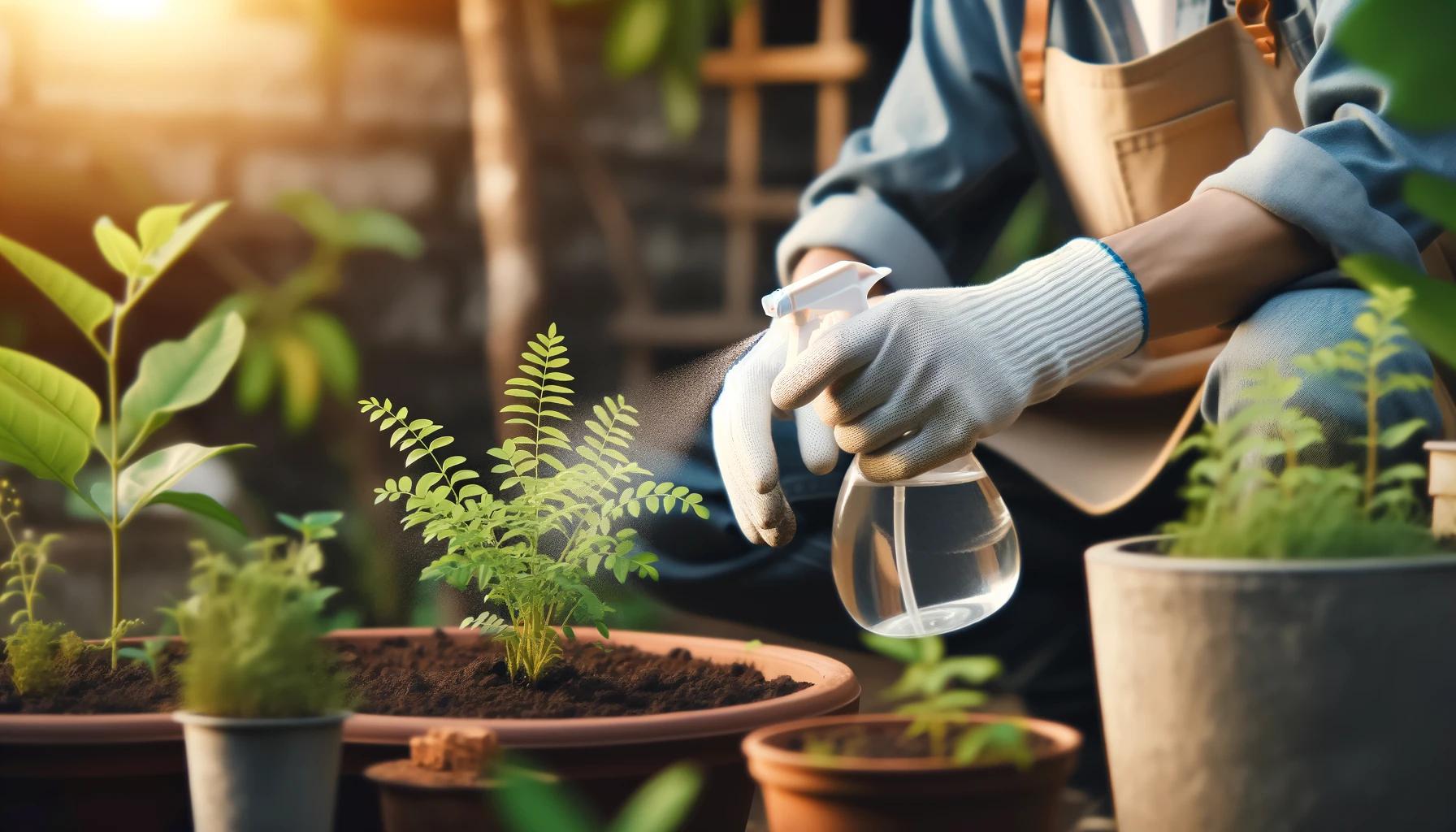Integrated Pest Management in Organic Gardening
Integrated Pest Management is a beacon of eco-conscious pest control, representing a significant shift from traditional, often chemically-reliant methods.

Integrated Pest Management (IPM) is not just a set of techniques; it's a philosophy that harmonizes with nature's rhythm.
It empowers you to tackle garden pests effectively while minimizing environmental harm.
This guide will walk you through every step of implementing IPM in your organic garden, transforming your approach to pest control into an eco-friendly art.
Essence of Integrated Pest Management (IPM)
IPM is a beacon of eco-conscious pest control, representing a significant shift from traditional, often chemically-reliant methods.
At its heart, IPM is about understanding the delicate balance within your garden's ecosystem and making mindful decisions to maintain it.

This involves integrating a variety of tactics:
- Biological Strategies: include using natural predators and parasites to control pest populations. For instance, introducing ladybugs to manage an aphid infestation capitalizes on the natural predator-prey relationship.
- Cultural Practices: This involves modifying your gardening practices to reduce pest problems. Crop rotation, proper plant spacing for better air circulation, and choosing disease-resistant plant varieties are cultural strategies that can significantly reduce pest issues.
- Physical and Mechanical Controls: This can be as simple as hand-picking pests off plants, using barriers like nets or fences to keep pests out, or employing traps to monitor or reduce pest populations.
- Chemical Controls: In IPM, chemical control is used as a last resort and focuses on using the least toxic options. Organic pesticides, such as neem oil or insecticidal soaps, are preferred when other strategies are insufficient.
By weaving these strategies together, IPM creates a multi-layered defense against pests, emphasizing prevention and minimal intervention.
This approach addresses immediate pest issues and contributes to your garden's long-term health and sustainability.
Identifying Garden Pests: Your First Line of Defense
Accurate pest identification is crucial in IPM. Different pests require different management strategies, so knowing exactly what you're dealing with is vital.
Here are some common garden pests and tips on how to identify them:
- Aphids: These small, sap-sucking insects are often found in clusters on new growth or the undersides of leaves. They can be green, black, brown, or pink and often leave behind a sticky residue known as honeydew.
- Snails and Slugs: These pests are known for their slimy trails and the damage they cause to leaves and young plant shoots. They are especially active at night and in moist conditions.
- Spider Mites: These tiny pests are difficult to see with the naked eye but can be identified by the delicate webs they weave on the undersides of leaves. They cause damage by piercing plant cells to feed.
- Caterpillars: The larvae of butterflies and moths, caterpillars can be identified by their elongated, worm-like bodies. They often cause damage by chewing on leaves.
Understanding the specific pests you are dealing with is essential for choosing the most effective IPM strategies.

Embracing Natural Pest Control Methods
In IPM, natural pest control methods are preferred for their minimal impact on the environment and non-target species. These methods include:
- Beneficial Insects: Introduce predators like ladybugs and lacewings, which feed on aphids, mites, and other tiny pests. Parasitic wasps are effective against caterpillars and whiteflies. These beneficial insects can be attracted to your garden by planting a diverse range of flowering plants.
- Insecticidal Soaps and Oils: These products are less harmful than synthetic pesticides and can be effective against various pests. Insecticidal soap breaks down the outer layer of pests like aphids and spider mites, while neem oil acts as a growth regulator and repellent.
- Physical Barriers: Row covers, nets, and fences can prevent pests from reaching your plants. Copper tape can deter snails and slugs, while floating row covers protect plants from flying insects.
- Diatomaceous Earth: This is a powdery substance made from the fossilized remains of diatoms. It works by cutting and dehydrating soft-bodied insects like snails and slugs.
These natural methods can effectively manage pests while keeping your garden safe for beneficial organisms and humans.
Preventative Practices: The Key to Sustainable Gardening
Preventive measures form the backbone of a successful IPM program. These practices aim to create an environment less conducive to pest infestations:
- Soil Health: Healthy soil supports strong plant growth. Use compost and organic matter to improve soil fertility and structure. Healthy plants are more resistant to pests and diseases.
- Crop Rotation: Each year, rotating crops help break the life cycles of pests and diseases associated with specific plants.
- Plant Selection: Choose disease-resistant varieties and plants suited to your local conditions. This reduces the likelihood of pest and disease problems.
- Diversity: Planting a variety of species promotes a balanced ecosystem. A diverse garden attracts beneficial insects and reduces the risk of large-scale pest infestations.
- Sanitation: Regularly remove plant debris and fallen leaves, which can harbor pests and diseases. Keep your garden tools clean to prevent the spread of pathogens.

Implementing these practices deters pests and enhances your garden's overall health and productivity.
Developing Your IPM Plan
Creating an effective IPM plan is a personalized process that involves understanding the unique characteristics of your garden.
Here's how to develop your plan:
- Regular Monitoring: Keep a close eye on your garden. Regular inspections help you catch pest problems early when they're easier to manage. Use sticky traps or pheromone traps to monitor insect populations.
- Accurate Identification: Once you detect a pest, identify it accurately. This step is crucial as it determines your course of action. Utilize resources such as gardening guides or local extension services for assistance.
- Assessment: Assess the level of pest infestation and the potential damage it can cause. Determine if the pest population is at a level that requires intervention. Sometimes, a small number of pests can be harmless and even beneficial, as they attract natural predators.
- Choosing Control Methods: Start with the least toxic and least disruptive methods. Consider cultural, mechanical, and biological controls first. If these are not effective, then consider using organic pesticides.
- Evaluation: After implementing a control method, monitor its effectiveness. Keep records of what you tried and how the pests responded. This information is invaluable for future pest management decisions.
Your IPM plan should be flexible, allowing you to adapt as conditions in your garden change.
This adaptive approach is key to managing pests effectively while minimizing environmental impact.

Monitoring and Adaptation in IPM
Success in IPM comes from being observant and adaptable. Here’s how you can incorporate these elements:
- Observation: Regularly walk through your garden, looking for signs of pest activity, plant stress, or disease. Pay attention to changes in plant appearance, such as discoloration, wilting, or unusual growth patterns.
- Record-Keeping: Keep a garden journal to record your observations, interventions, and their outcomes. This historical record becomes a valuable tool for understanding patterns and trends in your garden.
- Adaptation: Be prepared to modify your approach based on your observations. What works one season might not be effective the next. The ability to adapt your strategies is a hallmark of a skilled gardener and a successful IPM program.
Remember, IPM is not a static system but a dynamic process that evolves with your garden. Your keen observation and willingness to adapt are essential to its success.
Beneficial Insects and Nature’s Helpers
Embracing beneficial insects and natural helpers is a cornerstone of IPM. These allies play a crucial role in maintaining the ecological balance and aiding in pest control:
- Ladybugs: Voracious predators of aphids, mites, and other soft-bodied insects. Encourage ladybugs in your garden by planting dill, fennel, and yarrow.
- Lacewings: Their larvae are effective against various pests, including aphids, caterpillars, and mealybugs. Plants like cosmos and sweet alyssum attract lacewings.
- Parasitic Wasps: These tiny wasps lay their eggs inside or on pests like caterpillars and aphids. The hatching larvae consume the pest, effectively controlling its population. Plants that attract these wasps include marigolds and daisies.
- Ground Beetles: Excellent predators of slugs, snails, and other ground-dwelling pests. Ground beetles are attracted to gardens with plenty of mulch and ground cover.
Creating a habitat that encourages these beneficial creatures involves planting a diverse range of plants, providing shelter, and avoiding pesticides that can harm them.
You can significantly reduce pest problems in your garden by nurturing these natural helpers.

Conclusion: Embracing IPM for a Healthier Garden
Adopting Integrated Pest Management in your organic garden marks a commitment to sustainable and responsible gardening.
IPM is more than a collection of techniques; it's a mindset that values ecological balance, proactive problem-solving, and minimal intervention.
By implementing IPM, you're combating pests and nurturing a thriving garden ecosystem where every plant and creature has its place.
As you integrate these principles into your gardening practice, you'll find that your garden becomes more resilient to pests and transforms into a more vibrant, diverse, and ecologically sound space.
Embracing IPM is a step towards a more harmonious relationship with nature, where your garden flourishes as a testament to the power of working with, rather than against, the natural world.
Frequently Asked Questions
What is Integrated Pest Management (IPM), and how does it differ from traditional pest control?
IPM is a sustainable approach to pest management that emphasizes using a combination of methods (biological, cultural, physical, and chemical) to control pests in the most environmentally friendly way possible.
Unlike traditional pest control, which often relies heavily on chemical pesticides, IPM focuses on long-term prevention and minimal use of chemicals, aiming to balance effective pest control with environmental stewardship.
How can I identify the pests in my garden, and why is accurate identification important in IPM?
Accurate pest identification is crucial in IPM because different pests require different management strategies.
You can identify pests by closely observing their physical characteristics, the damage they cause, and their behavior.
Utilizing resources like gardening books, online databases, or local extension services can assist in proper identification.
Correct identification ensures you choose the most effective and least harmful control methods.
What are some natural methods for pest control that I can use in my garden?
Natural pest control methods include introducing beneficial insects (like ladybugs for aphids), using physical barriers (such as row covers or netting), applying organic pesticides (like neem oil or insecticidal soaps), and employing cultural practices (like crop rotation and proper plant spacing).
These methods are effective and environmentally friendly options for managing pests in your garden.
How can I attract beneficial insects to my garden to aid in pest control?
Attract beneficial insects by planting various flowering plants that provide nectar and pollen. Examples include yarrow, alyssum, and herbs like dill and fennel.
Additionally, avoid using broad-spectrum pesticides that can harm these beneficial insects.
Providing a diverse habitat with mulch and avoiding excessive tidiness can also encourage their presence.
Can IPM eliminate pests from my garden?
The goal of IPM is not to eliminate pests but to manage them at acceptable levels.
Complete eradication is often unrealistic and can disrupt the garden's ecological balance.
IPM focuses on maintaining pest populations at levels that do not cause significant damage to plants while preserving beneficial organisms.
How often should I monitor my garden for pests as part of my IPM strategy?
Regular monitoring is vital to successful IPM. It's recommended to inspect your garden at least once a week, paying close attention to the health of your plants and looking for early signs of pest activity.
Frequent monitoring allows for early detection and more effective, less invasive interventions.
What common preventative measures can I take to reduce the likelihood of pest infestations?
Preventive measures include practicing crop rotation, maintaining healthy soil through composting and mulching, choosing disease-resistant plant varieties, ensuring proper plant spacing for air circulation, and keeping the garden clean of debris where pests can breed.
These practices help create a less hospitable environment for pests and promote stronger, more resilient plants.
What should I do if my garden's natural pest control methods are ineffective?
If initial natural methods are ineffective, reassess the situation to ensure correct pest identification and consider modifying your approach.
Sometimes, changing cultural practices or enhancing biological controls can help.
Consider using more potent organic pesticides as a last resort, but always apply them responsibly and according to the manufacturer's instructions.



